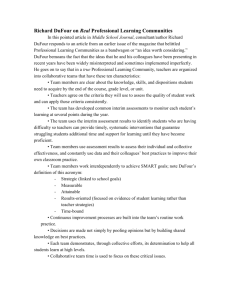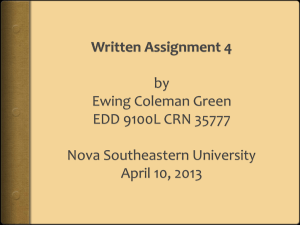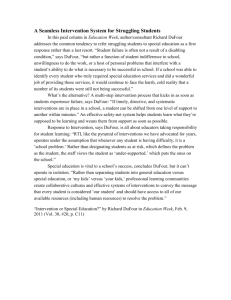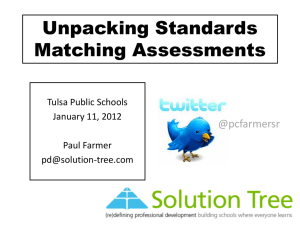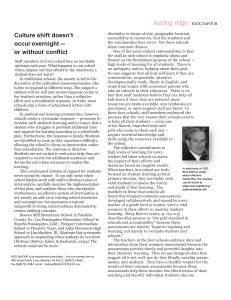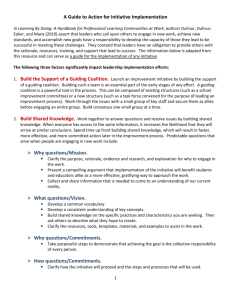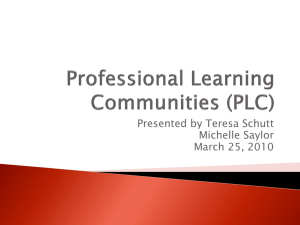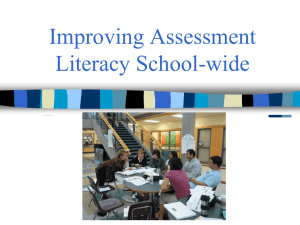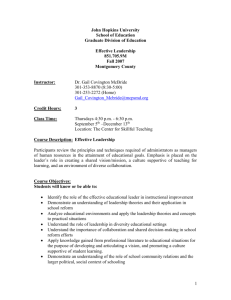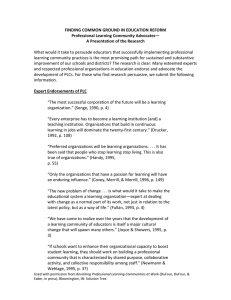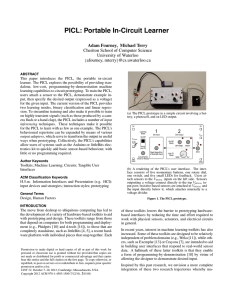CIM: An Elementary Approach
advertisement
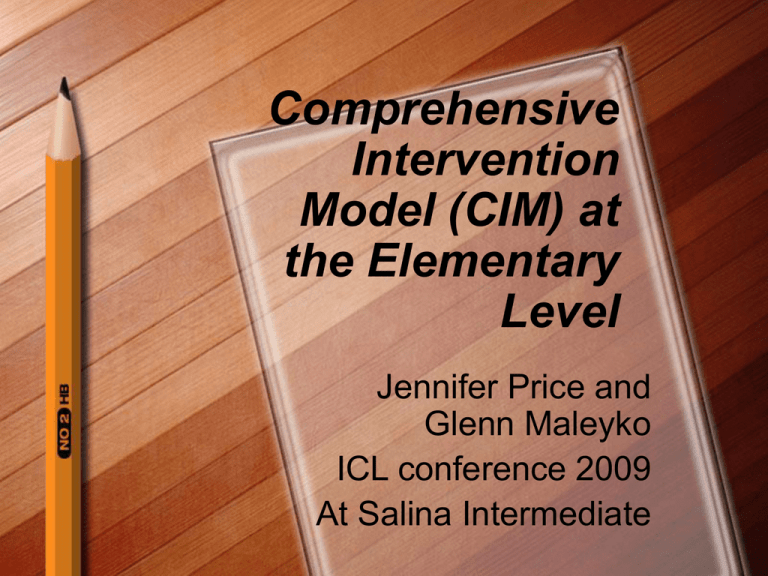
Comprehensive Intervention Model (CIM) at the Elementary Level Jennifer Price and Glenn Maleyko ICL conference 2009 At Salina Intermediate Team Collaboration and the 3 Essential Questions Question Three 3. How will we respond when they don’t learn? Salina Intermediate PLC Pyramid of Interventions IF STUDENTS DO NOT MEET EXPECTATIONS . . . 04-02-07 School: PICL MODEL Technology Integration Mentoring Peer Mediation Title I Tutoring Instructional Dialogues Communication Box Social Work intervention 21st Century Program Parent-Principal Forums SOS program Counseling Detention/ISS, Brunch with Social Workers CRSD Rec Program Social Work Interns Career Education Community Resource Center Bilingual Support Bullying Prevention Team/ Grade Level: Pullout Study Skills Support w/ Samira Bullying Intervention & Community Safety w/ William Ali Parent Liaison Support Home Visit Co-teaching Intervention Referral Process Parent Communication and Meeting DRA assessment Team Collaboration Time Classroom: Flexible Grouping Intervention Referral Teacher-student conference Classroom Behavior/ Academic Plan Formative assessment: follow-up & retest Student portfolios Classroom Behavior/ Academic Plan Differentiated Instruction Parent Conference/Contact PICL MODEL Advisor/Advisee Writing Program Team Collaboration and the 3 Essential Questions A new, fourth question is: How will we respond when they have learned? Salina Intermediate PLC Pyramid of Interventions 04-02-07 IF STUDENTS EXCEED EXCPECTATIONS . . . School: PICL MODEL Technology Integration Bullying Prevention IGNITE STAND Emerging Scholars DCMST Partnership Peer Mediators Academic Games Math Counts Student Council Academic Games CRSD Rec Program Inter-School Multicultural Technology Partnerships Media Broadcast Technology Camp Career Education Science Club Team/ Grade Level: Co-teaching Student Mentors Team Teaching Team Collaboration Time Classroom: Flexible Grouping Enrichment Activities Teacher-student conference Above Grade Level Assignments Differentiated Instruction Student led co-teaching presentations/lessons Technology Trainers Classroom leadership Committees or Clubs Advisor/Advisee Wrting Program The Triple P Core Components Personalization Precision Professional Learning Personalization Is education that puts the learner at the center(leadbeater, 2002), or more accurately puts each and every child at the center and provides an education that is tailored to the students’ learning motivational needs at any given time -Fullan, Hill, & Crevola, 2006 Precision To get something right. Precision is in the service of personalization because it means to be uniquely accurate, that is precise to the learning needs of individuals. Fullan, Hill, & Crevola, 2006 Professional Learning Breakthrough means focused on-going learning for each and every teacher. Daily learning is needed individually and collectively Schools need to work from the classroom outward. Not centrally developed PD Professional development works when it is school-based and embedded in the daily work of teachers - Fullan, Hill, & Crevola, 2006 Assessment Research by Rick Stiggins “The effect of assessment for learning on student achievement is some four or five times greater than the effect of reduced class size. Few interventions in education come close to having the same level of impact as assessment for learning. But the most intriguing result is that, while all students show achievement gains, the largest gains accrue to the lowest achievers. Everyone wins, with those who have the most to win, winning the most.” Breakthrough by Fullan, Hill and Crevola (2006) Assessment for learning, as every teacher knows is about obtaining feedback on the teaching and learning and using that feedback to further shape the instructional process and improve learning. Feedback Feedback to teachers enables them to focus their instruction; feedback to students enables them to monitor and improve their learning. -Fullan, Hill, & Crevola, 2006 Salina Intermediate 4th and 5th Grade model We knew that we needed to schedule something for our students We had the information and research/experience from the 6th 8th grade We decided last year to do something following a training session with Dr. Dorn Brainstorming Due to the fact that the elementary schedule is structurally different we had to brainstorm how we could do this. The 4th and 5th grade teachers came up with an idea that evovled over time We decided on one hour a day for 4th grade and one hour a day for 5th grade Scheduling began in May/June We decided not to unleash the model until November after we could implement training and preparation. Leadership Ms. Price and Ms. Shami then took over the logistics planning This was completed in conjunction with the training by Carole Lower. Comprehensive Intervention Model (CIM) Elementary- 4th and 5th Grade Glenn Maleyko and Jennifer Price Layers of Support Core Classroom Instruction Tier I - Classroom Intervention Tier II – Intervention Specialist Tier III – Intervention Specialist Tier IV – Special Education Types of Intervention Groups Reading Recovery (RR) Emergent Language and Literacy Group (ELLG) Guided Reading Plus (GRP) Assisted Writing Group (AWG) Writing Process Group (WPG) Comprehension Focus Group (CFG) Content Strategy Groups (CSG) Initial Placement Student Information Form DRA (Directed Reading Assessment) – Levels 24 or lower Writing Sample- PCL writing sample using the 6+1 rubric Gentry Spelling Inventory DOLCH list Running Records Writing Samples Observations of reading and writing Formative Assessment Progress Monitoring Running records- unseen text at the child’s instructional level, as needed NAEP (National Assessment of Educational Progress) Oral Reading Fluency Scale- used to analyze the student’s oral reading. Writing samples- assess an independent writing sample every 2 weeks. Observation notes on reading and writing Guided Reading Plus (GRP) Emergent through early transitional stages of reading and writing Designed to promote monitoring and self –correcting strategies, fluency, strategies for deeper comprehension and vocabulary development in reading Two day sequence Day 1– Phonological Awareness and/or phonics – Guided reading Day 2– Reading assessment – running record – Independent reading – Writing about reading (writing strategy lesson, writing prompt, individual conference) – Reading and writing analysis Comprehension Focus Groups (CFG) Students at the transitional stage and beyond Difficulty comprehending the wide range of text genres Develop students’ reading and writing knowledge for narrative, information and persuasive Three Phases – Phase I and II – Reading several texts from one genre responding to the reading through discussion and in response logs completing text maps for the genre being studied Repeat phases I and II for each book in the genre – Phase III – Writing in the focus genre Takes place after the students have had the opportunity to read and respond to all of the books in the unit. Exit Criteria 4th grade – DRA level 30 or higher – NAEP – Writing prompt, graded with the 6+1 rubric • 5th grade – DRA level 40 or higher – NAEP – Writing prompt, graded with the 6+1 rubric Presentation References Covey, S. (2004). The 8th habit: From effectiveness to greatness. New York, NY: Franklin Covey Co. Downey, Steffy, English, Frase & Poston (2004). The Three Minute Classroom WalkThrough. Dufour, R., Dufour, R., Eaker, R. & Many, T. (2006). Learning by Doing. Bloomington, IN: Solution Tree. Dufour, R., Dufour, R., Eaker, R., & Karhanek. (2004). What ever it takes: How professional learning communities respond when kids don’t learn. Bloomington, Indiana: Solution Tree Dufour, R., Dufour, R., & Eaker, R. (2002). Getting started: Reculturing schools to become professional learning communities. Solution Tree: Bloomington, Indiana. Dufour, R. & Eaker, R. (1998). Professional Learning Communities at Work: Best Practices for Enhancing Student Achievement. Bloomington, Indiana: Solution Tree. Education Week,, (2002) Technology in Education, October 1st, 2003. Fullan. (2008). The Six Secrets of Change. Fullan, Hill, & Crevola. (2006). Breakthrough. Prentice-Hall. Gardner () Do Technology Based Lessons Meet the Needs of Student Learning Styles Jackson, Anthony W & Davis, Gayle (2000). Turning Points 2000: Educating Adolescents in the 21st Century. Marzano, R. (2006). Classroom Assessment and Grading that Work. ASCD Publications. Presentation References Marzano, R., Waters, T., & McNulty, B. A. (2005). School Leadership that works: From Research to Results. National Association of State Boards of Education (2002) McLaughlin, M., & Talbert, J. (2001). Professional learning communities and the work of high school teaching. Chicago: University of Chicago Press. Sarason, S. B. (1996). Revisiting ‘The culture of the school and the problem of change’. New York: Teachers College Press. Souden, Mike (2003). Evolution of Standards: Enhanced Information opportunities that technology provides. Taken on October 24, 2003, form www.macul.org Stiggins, R. (2004). Student Involved Classroom Assessment: 3rd Edition. Prentice Hall.
